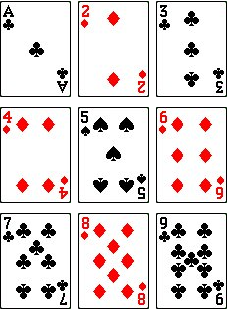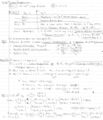12-240/Classnotes for Thursday October 18: Difference between revisions
m (→Riddle Along: editting typo) |
No edit summary |
||
| (11 intermediate revisions by 6 users not shown) | |||
| Line 11: | Line 11: | ||
{{12-240:Dror/Students Divider}} |
{{12-240:Dror/Students Divider}} |
||
===Linear transformation=== |
|||
== Theorems == |
|||
1. If G generates, |G| <math>\ge \!\,</math> n and G contains a basis, |G|=n then G is a basis |
|||
'''Definition:''' |
|||
2. If L is linearly independent, |L| <math>\le \!\,</math> n and L can be extended to be a basis. |L|=n => L is a basis. |
|||
A function L: V-> W is called a linear transformation if it preserve following structures: |
|||
3.W <math>\subset \!\,</math> V a subspace then W is finite dimensioned and dim W <math>\le \!\,</math> dim V |
|||
1) L(x + y)= L(x) + L(y) |
|||
If dim W < dim V, then any basis of W can be extended to be a basis of V |
|||
2) L(cx)= c.L(x) |
|||
Proof of W is finite dimensioned: |
|||
3) L(0 of V) = 0 of W |
|||
Let L be a linearly independent subset of W which is of maximal size. |
|||
'''Proposition:''' |
|||
: Every subset A of '''N''', which is: |
|||
1) property 2 => property 3 |
|||
1. Non empty |
|||
2 |
2) L: V -> W is a linear transformation iff <math>\forall\,\!</math> c <math>\in\,\!</math> F, <math>\forall\,\!</math> x, y <math>\in\,\!</math> V: L(cx + y)= cL(x) + L(y) |
||
'''Proof:''' |
|||
has a maximal element: an element m <math>\in \!\,</math> A, <math>\forall\!\,</math> a <math>\in \!\,</math> A, a <math>\le \!\,</math> m ( m + 1 <math>\notin \!\,</math> A ) |
|||
1) take c= 0 in F and x=0 in V. Then L(cx)=cL(x) -> L(0 of F * 0 of V)=(0 of F)*L(0 of V)=0 of W |
|||
== class note == |
|||
2)(=>)Assume L is linear transformation |
|||
L(cx + y)= L(cx) + L(y)= c*L(x) + L(y) |
|||
| ⚫ | |||
| ⚫ | |||
| ⚫ | |||
Image:12-240-Oct-15-Page-3.jpg |page3 |
|||
| ⚫ | |||
(<=) 1. Follows from L(c*x+y) = c*L(x)+L(y) by taking c=1 |
|||
2. Follows by taking y=0 |
|||
'''Examples''' |
|||
1. L: '''R'''^2 -> '''R'''^2 by |
|||
2. P,Q: P(F) |
|||
== lecture note on oct 18, uploaded by [[User:starash|starash]]== |
== lecture note on oct 18, uploaded by [[User:starash|starash]]== |
||
| Line 49: | Line 53: | ||
Image:12-240-1018-1.jpg |page1 |
Image:12-240-1018-1.jpg |page1 |
||
Image:12-240-1018-2.jpg |page2 |
Image:12-240-1018-2.jpg |page2 |
||
| ⚫ | |||
== Lecture notes uploaded by [[User:Grace.zhu|gracez]] == |
|||
| ⚫ | |||
| ⚫ | |||
| ⚫ | |||
</gallery> |
</gallery> |
||
Latest revision as of 21:40, 12 December 2012
| |||||||||||||||||||||||||||||||||||||||||||||||||||||||||
Riddle Along
The game of 15 is played as follows. Two players alternate choosing cards numbered between 1 and 9, with repetitions forbidden, so that the game ends at most after 9 moves (or four and a half rounds). The first player to have within her/his cards a set of precisely 3 cards that add up to 15 wins.
Does this game have a winning strategy? What is it? Who wins, the first to move or the second? Why am I asking this question at this particular time?
See also a video and the transcript of that video.
| Dror's notes above / Students' notes below |
Linear transformation
Definition:
A function L: V-> W is called a linear transformation if it preserve following structures:
1) L(x + y)= L(x) + L(y)
2) L(cx)= c.L(x)
3) L(0 of V) = 0 of W
Proposition:
1) property 2 => property 3
2) L: V -> W is a linear transformation iff c F, x, y V: L(cx + y)= cL(x) + L(y)
Proof:
1) take c= 0 in F and x=0 in V. Then L(cx)=cL(x) -> L(0 of F * 0 of V)=(0 of F)*L(0 of V)=0 of W
2)(=>)Assume L is linear transformation
L(cx + y)= L(cx) + L(y)= c*L(x) + L(y)
(<=) 1. Follows from L(c*x+y) = c*L(x)+L(y) by taking c=1
2. Follows by taking y=0
Examples
1. L: R^2 -> R^2 by
2. P,Q: P(F)








